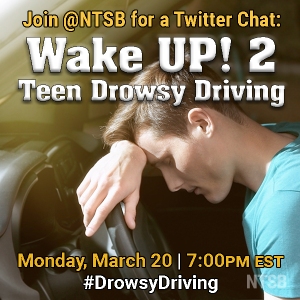Teens and Drowsy Driving
Sleepiness while driving can have serious consequences. The NTSB has investigated numerous crashes in which driver drowsiness played a role. Today marks the first anniversary of one of those crashes.
On March 20, 2016, four teens were traveling home from a weekend trip to South Padre Island, Texas. At about 1:57 pm, the driver lost control of the car, crossed the center median, entered the opposing lanes of traffic, and collided with a truck-tractor semitrailer. The driver was seriously injured and her three friends died. The Board determined that that the driver’s loss of control was due to inattention resulting from her fatigue.
NTSB investigators learned that, in the 24 hours before the crash, the driver had very little opportunity for sleep—only about 5 hours on the morning of the crash.
According to the CDC, motor vehicle crashes are the leading cause of death for teens in the United States, and recent AAA Foundation for Traffic Safety research shows that one in five fatal crashes involves a drowsy driver. Other research shows that drivers aged 16 to 24 are at the greatest risk of being involved in a drowsy driving crash.
In a recent AAA Foundation study, many drivers who understood the risks of drowsy driving admitted they had, nonetheless, driven while fatigued. Specifically, the AAA survey found that 96 percent of drivers see drowsy driving as a serious threat and a completely unacceptable behavior; however, among that same group, 3 in 10 admitted to driving when they were so tired that they had a hard time keeping their eyes open.
Lack of sleep slows reaction time and makes us more susceptible to forgetting or overlooking important tasks. A few seconds is all it takes to drift out of the lane or to miss a stopped vehicle ahead.
Although it’s not always possible to predict when you will become drowsy behind the wheel, there are several steps you can take to help avoid this risk. Today, to call attention to the risk posed by driving drowsy, the NTSB is releasing a new Safety Alert, Drowsy Driving Among Young Drivers.
Jana Price, PhD, is a Senior Human Performance Investigator in NTSB’s Office of Highway Safety.



